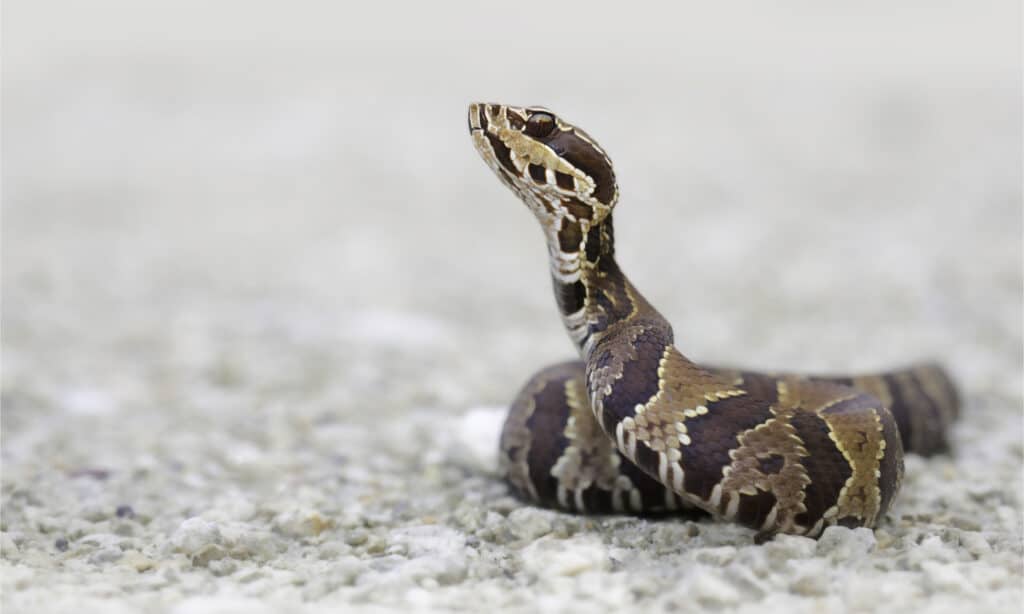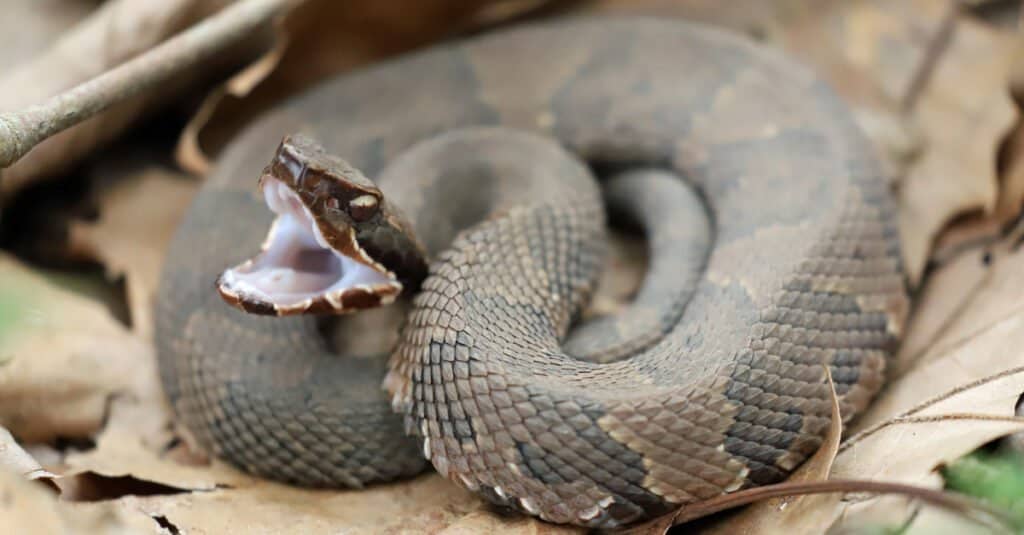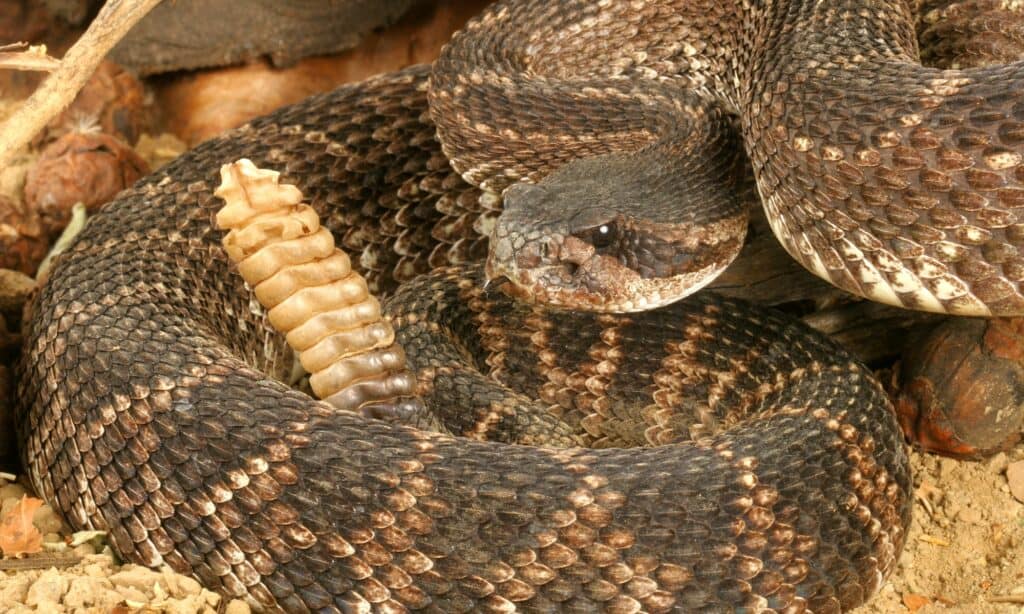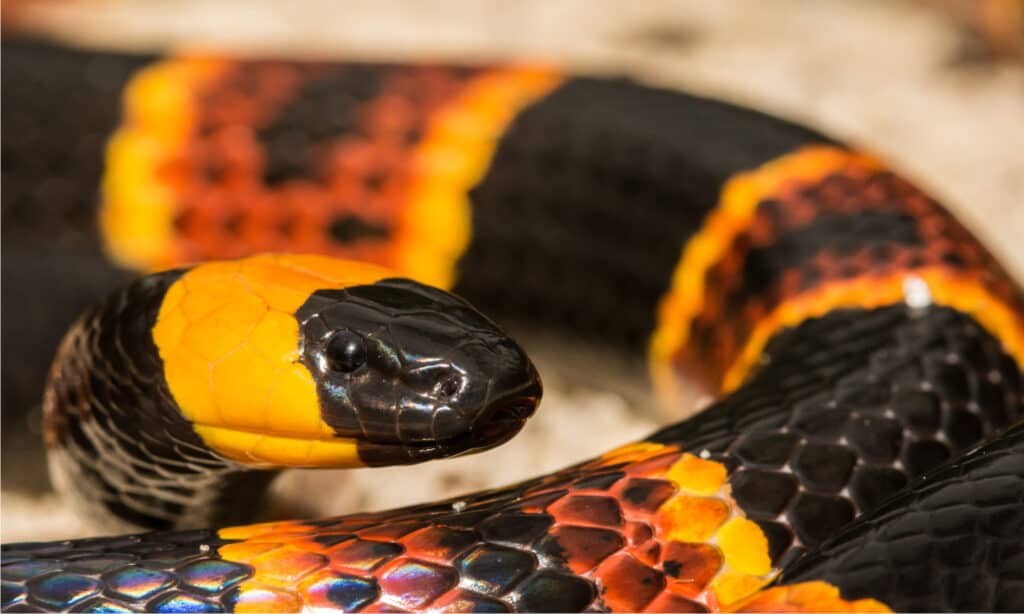If you’re planning an outdoor trip down south, you may be interested in learning more about the cottonmouths in Georgia. Cottonmouths are a common type of venomous snake in the southern United States. However, it can be difficult to recognize them. There’s also a lot of mystery surrounding just how much of a threat cottonmouths pose when it comes to your hike in the woods.
So, are you ready to learn more about the cottonmouths in Georgia and their bite? Keep reading!

Cottonmouths are considered one of the few semi-aquatic snakes in the world.
©jo Crebbin/Shutterstock.com
About Cottonmouths
Cottonmouths (Agkistrodon piscivorus), also known as water moccasins, are a type of venomous snake in Georgia. They can be found as far north as Virginia, as far south as Florida, and even further west than Louisiana.
These venomous snakes come in a variety of colorations. However, they’re typically a dark red color with darker brown or black markings. They have a triangular head, as is common for most venomous snakes. (NOTE: A triangular head is not the only way to identify a venomous snake, as some non-venomous snakes flatten their heads into triangular shapes to mimic deadly species.) Cottonmouths get their name from the white inside of their mouth, which can be seen from their defensive displays. Unlike rattlesnakes that rattle their tail to let you know you’ve come too close, cottonmouths will coil up and open their mouths wide, showcasing their namesake coloration and venomous fangs.
Typically, cottonmouths are average-sized venomous snakes. They can grow to be anywhere from 2 to 4 feet long. However, they can be larger. The largest cottonmouth recorded so far was 74 inches long — over 6 feet! This snake wasn’t found in Georgia, however. Instead, it was found in a swamp on the Virginia-North Carolina border.
Cottonmouths are what are known as opportunistic feeders. This means that they eat almost everything available to them. Some of the most common prey of cottonmouths in Georgia include:
- Frogs
- Toads
- Lizards
- Snakes — including smaller cottonmouths
- Turtles
- Young alligators
- Squirrels
- Rats and mice
- Rabbits
- Birds
- Fish.
Due to their semi-aquatic lifestyle, amphibians and fish are the most common prey of the cottonmouth. However, despite being able to prey on so many different types of animals, there are also several predators of the cottonmouth. This includes birds of prey, such as hawks and larger snakes.
Cottonmouth Lifespan
Cottonmouths live anywhere up to 10 years old in the wild. You can approximate their age by observing the vibrancy of the scales on their back. Younger snakes will have extremely bright and vivid stripes, whereas older snakes become darker, and their pattern slowly fades away to a solid color.
The oldest known cottonmouth lived to be over 24 years old, although this is highly unlikely to occur in the wild. Female cottonmouths have litters of 1-20 babies. Unlike most reptiles, cottonmouths do not lay their eggs but give live birth. Most of the mother’s litter will not survive to adulthood as the young make prey for other larger predators in the area.

This young cottonmouth displays brilliant colors as opposed to the faded patterns of older snakes.
©Kristian Bell/Shutterstock.com
Where Can Cottonmouths Be Found in Georgia?
Cottonmouths can be found almost anywhere water can be found in Georgia. Although they’ll stray away from the salty waters of the beach and estuaries, they have plenty of other habitats in the state. From swamps to creeks to lakes, cottonmouths can make themselves at home almost everywhere.
Typically, however, cottonmouths aren’t a common sight in northern Georgia. Although they can live in this region, they’re much more common in the southern areas of the state.
Is It Normal for a Cottonmouth to Bite?
Cottonmouths can be dangerous, especially because of their venom. However, thankfully, bites from a cottonmouth are extremely rare. This is because they don’t see us as prey or necessarily as a predator. As a result, they’d much rather mind their business or flee during an encounter than try to bite you.
However, a cottonmouth will bite if they feel threatened. If you happen to miss a cottonmouth snake and step on it, which can be easy due to its coloration, it’ll often bite out of fear and pain.

A cottonmouth will bite if they feel threatened.
©KF2017/Shutterstock.com
What to Do About a Venomous Snake Bite?
A venomous snake bit is considered a medical emergency. If you happen to stumble across a cottonmouth and are bitten, it is important to seek medical attention immediately. Thanks to modern technology and medicine, snake bites are rarely fatal. However, postponing medical care can lead to permanent side effects or death.
Other Venomous Snakes in Georgia
While the cottonmouth is one of the more noticeable species, Georgia is actually home to several other venomous snakes. Some of these include the copperhead, different species of rattlesnake, and even the eastern coral snake.
Copperhead
Copperheads are a common venomous snake in the southern United States. They’re named for their rusty color, which figures a tell-tale hourglass pattern. Copperheads are found only in North America naturally.

The copperhead’s scales are keeled, and their eyes have vertical pupils that make them resemble a cat’s eyes.
©Creeping Things/Shutterstock.com
Rattlesnake
Rattlesnakes are some of the most common venomous snakes in all of North America, as well as some of the most dangerous. Georgia is home to three different rattlesnake species: the pigmy rattlesnake, the timber rattlesnake, and the eastern diamondback snake. The eastern diamondback rattlesnake is the most venomous snake in North America.
You can identify a rattlesnake by its tail. There, you can find a large rattler that they use to warn away predators.

You can identify a rattlesnake by its tail.
©iStock.com/johnaudrey
Coral Snake
The eastern coral snake is one of the most venomous species of snake. Many snake species, such as the kingsnake, use this reputation to their favor by mimicking the color pattern of the coral. However, you can identify them by which colored bands are touching. The old saying for this is, “Red on yellow will kill a fellow. Red on black will give him some slack.”

The fangs of the Eastern Coral Snake are small and do not fold back into its mouth when its mouth is closed.
©Jay Ondreicka/Shutterstock.com
The photo featured at the top of this post is © Nicole Ramsey/Shutterstock.com
Discover the "Monster" Snake 5X Bigger than an Anaconda
Every day A-Z Animals sends out some of the most incredible facts in the world from our free newsletter. Want to discover the 10 most beautiful snakes in the world, a "snake island" where you're never more than 3 feet from danger, or a "monster" snake 5X larger than an anaconda? Then sign up right now and you'll start receiving our daily newsletter absolutely free.
Sources
- The News and Observer, Available here: https://www.newsobserver.com/news/state/north-carolina/article251580948.html
Thank you for reading! Have some feedback for us? Contact the AZ Animals editorial team.






